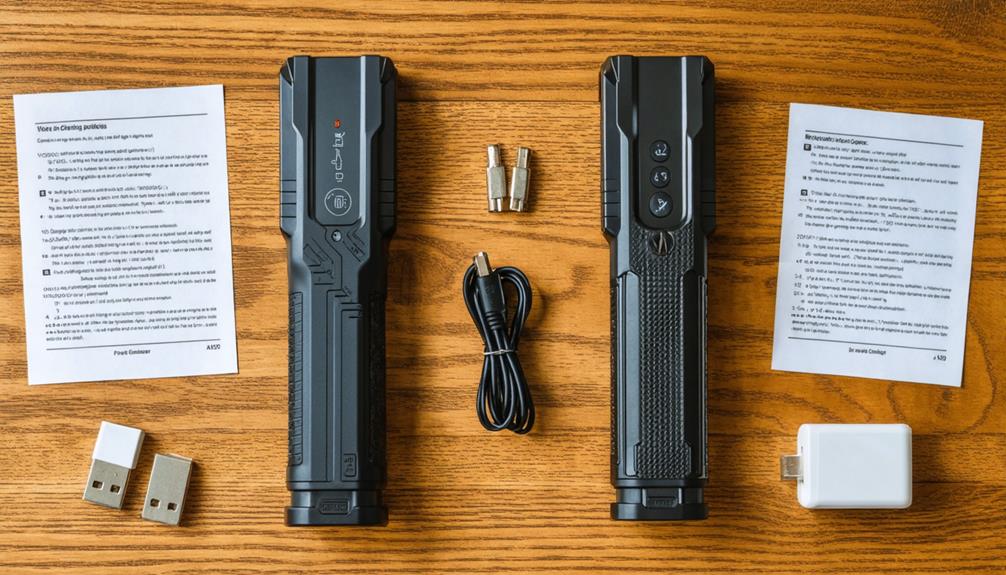
Brainstorm Security Shop

For Orders Over $199

On Any Of Our Products

Details On Refund Page

The debate surrounding stun gun variations is both intricate and multifaceted, involving numerous factors such as voltage capacity, ergonomic design, and supplementary features. With models ranging from low to high voltage, the choice impacts not only the effectiveness of the device but also aligns with specific legal constraints and personal safety needs. Moreover, the evolution of design—from compact, easily concealable versions to those equipped with advanced safety mechanisms—emphasizes the importance of understanding one’s options. As we explore these distinctions, one must consider how these elements collectively influence the efficacy and legal standing of stun guns in diverse scenarios.
When considering the various types of stun guns, what distinguishes one model from another? The primary factors that set them apart include self defense effectiveness and battery life.
Stun guns are diverse in their design and operation, each tailored to meet specific defense needs. Compact models, such as mini stun guns, are favored for their portability and ease of concealment, making them ideal for quick use in emergencies. Despite their size, many maintain a high level of self defense effectiveness, delivering a powerful charge to incapacitate potential threats temporarily.
The battery life of a stun gun significantly impacts its reliability and readiness. Rechargeable models are increasingly popular, offering the advantage of being cost-effective and environmentally friendly. They are equipped with lithium-ion batteries that offer longer usage time and quicker charging capabilities.
On the other hand, stun guns powered by disposable batteries may require more frequent replacements but are often more affordable upfront.
Ultimately, the choice of stun gun depends on the user’s personal preference and needs. Whether prioritizing self defense effectiveness or battery life, it is crucial to select a model that consistently demonstrates reliability and effectiveness in safeguarding its user.
Voltage is a critical factor that distinguishes various stun gun models, directly influencing their power and effectiveness. Stun guns operate by delivering an electrical charge to temporarily incapacitate an assailant, and the voltage level plays a pivotal role in determining the intensity of this charge.
High voltage stun guns typically range from 10 million to 30 million volts, designed to penetrate clothing more effectively and deliver a more potent shock to the target. These devices are often favored for their ability to swiftly subdue an attacker, making them a popular choice for personal defense.
Conversely, low voltage stun guns generally range from 1 million to 5 million volts. While they may not deliver as intense a shock as their high voltage counterparts, they still provide a significant deterrent effect.
Low voltage models may be preferable in situations where a less aggressive approach is desired or where there is a need for more precise control over the application of force. It is essential for users to consider their specific needs and environments when choosing between high and low voltage stun guns, as the right voltage can significantly impact the device’s suitability for personal safety.
While voltage is a key determinant of a stun gun’s effectiveness, the size and design of the device hold significant importance in its practical application.
Compact models are favored for their portability, making them easy to carry and conceal. These smaller devices are particularly beneficial for personal defense, allowing individuals to respond swiftly in threatening situations. Conversely, larger models, though less discreet, may offer enhanced power and durability.
The ergonomic grips of stun guns significantly influence their usability. An ergonomic design ensures that the device is comfortable to hold, reducing the risk of slippage during use. This aspect is crucial for maintaining control in high-stress scenarios.
Additionally, the design should facilitate quick access to the activation button, ensuring that the user can deploy the device without fumbling.
Consider the following factors when selecting a stun gun based on size and design:
Ultimately, the choice of size and design should align with the user’s specific needs and intended use.
A stun gun‘s functionality is greatly enhanced by its features and extras, which can significantly impact its effectiveness and user experience. Among the critical aspects of a stun gun’s design are the safety features, which ensure that the device operates securely and minimizes accidental discharge.
Common safety features include a safety switch or button that must be engaged before the stun gun can be activated. This simple yet crucial addition provides peace of mind and enhances user confidence during operation.
Battery life is another vital feature that influences the practicality of a stun gun. Reliable battery performance ensures that the device is ready for use when needed, without the inconvenience of frequent recharging or replacement.
Modern stun guns often incorporate rechargeable batteries, which offer the dual benefits of cost savings and environmental friendliness. Some models even feature an LED indicator to alert the user when the battery is low, ensuring optimal performance.
Additional extras, such as built-in flashlights or carrying cases, can further enhance the user experience. A flashlight can serve dual purposes, providing illumination in dark environments and aiding in target identification.
Carrying cases offer convenient storage and protection, ensuring the stun gun remains in top condition.
Understanding the legal considerations surrounding stun guns is crucial for potential users to ensure compliance with local laws and regulations. As devices frequently used for self-defense, stun guns are subject to a complex array of self-defense laws and state regulations that vary across jurisdictions. It is essential for individuals to be aware of these legal nuances to avoid potential legal complications.
Staying informed about these legal considerations is paramount for responsible stun gun ownership and usage.
Stun guns deliver an electrical shock, disrupting the nervous system and causing temporary incapacitation. Stun gun safety is paramount, ensuring minimal risk and avoiding prolonged exposure to prevent potential harm to the cardiovascular and muscular systems.
Stun gun types typically require direct contact to deliver an electric shock, whereas taser features include firing barbs that connect to a target from a distance, allowing for remote incapacitation. Both devices aim to temporarily immobilize an individual.
In animal encounters, employing self-defense techniques is crucial. Stun guns can be a viable option for deterring aggressive animals by delivering an electric shock, although effectiveness varies based on the animal’s size and the stun gun’s power.
To ensure optimal performance of stun guns, regular maintenance is crucial. Focus on battery care by routinely checking charge levels and replacing as needed. Additional performance tips include cleaning contacts and verifying functionality to maintain reliability.
The legal age for purchasing stun guns varies across jurisdictions, with state regulations playing a significant role. It is crucial to consult local laws to determine specific age requirements and ensure compliance with applicable legal standards.
Brainstorm Security Shop
1867 Caravan Trail
Ste 105
Jacksonville, FL 32216
Call us toll free: (800) 859-5566